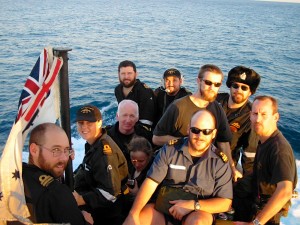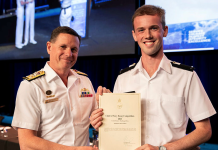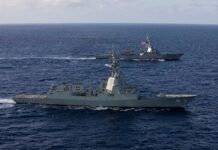Commodore P.M.J. Scott, CSC, RAN*
ANI Address, Sydney, NSW – 23 May 2014
IT IS appropriate to deliver this address here in Sydney, a port that has been home to more of our accumulated submarine history than any other. That history includes, of course, the arrival of our first submarines, His Majesty’s Australian Submarines AE1 and AE2, as they joined the newly formed Fleet of the Royal Australian Navy, one hundred years ago tomorrow.
1914 – just over a decade after Federation, and just under a decade since the global naval powers made their first serious ventures into the submarine domain. The formation of our Fleet, now replete with its submarine element, was significant on many accounts, but not the least as a clear statement of the Nation’s intent to uphold it’s sovereignty, secure it’s borders and protect it’s interests, and as an irrefutable demonstration of it’s capacity to do so.
 This evening I will speak of the immense significance of Australia’s submarines over the past century across numerous dimensions, including their proud history, their unique capabilities, their potency and their deterrent effect. I will seek to expose for you what it is that distinguishes submarines and the submarine capability from other elements of naval and national power, because in my view it is those distinguishing features that point to the true significance of our submarines.
This evening I will speak of the immense significance of Australia’s submarines over the past century across numerous dimensions, including their proud history, their unique capabilities, their potency and their deterrent effect. I will seek to expose for you what it is that distinguishes submarines and the submarine capability from other elements of naval and national power, because in my view it is those distinguishing features that point to the true significance of our submarines.
I will also speak of what I perceive to be the clear relevance and even greater significance of the submarine capability for our nation into the future. But I would like to begin, perhaps a little surprisingly, by talking about how and when our submarine capability has fallen short of real significance.
Submarines Not Yet Realised
There is an entire century or more of Australia’s existence as a nation where submarines were totally irrelevant; it is, of course, the hundred plus years before the first realisation of submarines as viable weapons systems. Prior to the 20th Century, mankind existed on the land or on the sea. The waging of war was confined to ranging across the surface of one or the other, because life in the through-air and undersea domains was simply unviable. Indeed, the entire undersea domain was largely unexplored and unknown. Critically, the potential of the undersea domain was almost totally unrealised.
The invention and militarisation of both aircraft and submarines changed this dynamic rapidly, globally and irrevocably. From the moment of their invention and weaponisation, submarines ‘writ large’ became immediately significant to the sovereignty, security, and prosperity of our island nation; whether we knew it or not. A first, and fleeting, glimpse of that significance would be caught at the outbreak of the First World War, when AE1 and AE2 were immediately deployed into action with the Fleet, securing Australian and regional waters, escorting our troops overseas and, for AE2, conducting combat operations during the Dardenelles campaign. But no doubt you will hear more of their misadventures and exploits tomorrow.
Submarines in Insufficient Strength
It is difficult to mount a convincing argument toward the true significance of a capability that is weak, fragile, unproven, or sporadic. Regrettably, for much of our early naval history, one or more of these characteristics applied to our submarine forces. Notwithstanding the proud service and achievements of both AE1 and AE2, with a force structure of only two boats, our first ‘submarine capability’ was totally lost – irretrievably sunk – within eight months of the declaration of a war which would last four long years.
Whilst the J-class were acquired in moderate numbers, with a flotilla of six hulls, and were supported by a dedicated tender, they were in such poor mechanical condition that they never presented as a formidable force. The Odin Class submarines were acquired in precisely the same inadequate numbers as the E-boats. While they gave the RAN a brief taste of the evolved capabilities of a post war submarine, with just two hulls, Oxley and Otway, the Class was always beneath critical mass and would never achieve the strength of a dependable, flexible, meaningful force for our Navy. The acquisition of a single submarine, the HMAS K9, in 1943, proved less than effective, even with the limited aspiration of training the Fleet in Anti-Submarine Warfare. Whilst it is patently true that a single submarine can sink three cruisers before breakfast, a sole submarine does not a submarine capability make!
Submarines Absent from the Order of Battle
Of course, even less significant than a weak force, is a non-existent force. Notwithstanding a number of attempts at establishing a submarine capability over the course of the century, and acknowledging the presence a small flotilla of British submarines in Sydney between 1949 and 1969, the Royal Australian Navy was typically without an organic Submarine Arm in any given year from the 1920’s to the 1960’s.
Submarine Capability Shapes Our Fate
There was, however, one period of time within those decades when submarine capability was extremely and prominently significant for Australia. That period was, of course, the Second World War. Whilst submarines were absent from the RAN order of battle, the submarine forces of many other nations played a direct hand in the fate of ours over the course of that conflict. I am speaking, in particular, of the submarine forces of both Japan and Germany, which menaced and sank our shipping and raided our ports, including this very port of Sydney. Those submarines, whilst small in number in our waters, constituted a threat that went almost completely unanswered, as Australia had no direct or effective response to them.
I am also speaking of the Allied submarines that waged the war against the Japanese, including the more than 170 American, British and Dutch boats that pushed into theatre from the massive submarine bases in Brisbane and Fremantle. Operating over vast distances, they took the war to our enemies and inflicted crippling losses that fundamentally enabled eventual victory in the Pacific.
What Distinguishes Our Submarines?
It is perhaps worth asking at this juncture what it was that distinguished those submarines from other elements of naval or military power? What were the defining characteristics of the enemy submarines that meant we were unable to counter them? What were the defining characteristics of the Allied submarines that enabled them to operate so effectively throughout what we now call the Indo-Pacific region?
 In my view, there are at least six aspects that were extant then, and remain entirely germane to Australia’s submarine capability today and into the future. They are: Continuity of the Force, Range and Endurance, Independence of Operation, Stealth, Potency, and the resultant Deterrent Effect. As these are the characteristics that generate advantages for our submarines, and which define them as our pre-eminent naval weapon system, I would like to speak to each of them in turn.
In my view, there are at least six aspects that were extant then, and remain entirely germane to Australia’s submarine capability today and into the future. They are: Continuity of the Force, Range and Endurance, Independence of Operation, Stealth, Potency, and the resultant Deterrent Effect. As these are the characteristics that generate advantages for our submarines, and which define them as our pre-eminent naval weapon system, I would like to speak to each of them in turn.
Force Continuity
I mentioned that a sole submarine is not a submarine force. In a similar vein, a submarine force is more than a collection of hulls. It is the synthesis of platforms, weapons and sensors with a body of knowledge, skill and experience. It takes years, perhaps decades, to build a fully functional and professional submarine force. The Allied submarine forces expanded rapidly from the onset of the Second World War, but importantly they did so from a foundation of several decades of continuous submarine operations.
Perhaps the most significant aspect of the introduction of the Collins was that we actually transitioned our submarine capability from one class to another, rather than suffering the total loss of the capability and then re-introducing it again, as had been our previous experience through the Century. That said, between the mid 1990’s and the mid 2000’s the Submarine Arm was incredibly stretched across the simultaneous demands of sustaining and operating the Oberons, designing and building the Collins, and introducing the Collins into operational service whilst shouldering parent Navy responsibilities for the Class.
It would be generous in the extreme to say that we did not suffer a capability gap, but we did manage to maintain a degree of force continuity and it was the first time we had achieved the operation of consecutive classes of submarine.
Range and Endurance
It is no mere coincidence that the most successful submarines of the War in the Pacific were the Fleet submarines of the United States Navy. Long range, ocean going submarines, they were capable of operating forward, thus optimizing their ability to threaten and interdict merchant and naval shipping.
Our strategic geography remains unchanged from those years and still demands that our Fleet units, both submarines and surface ships, have extended range and endurance. These traits have been particular strengths of both the Oberons and the Collins. Having the range to patrol well beyond Australia’s shores, and the endurance to deliver poise and presence on station, means that our submarines can operate, and survive, wherever their strategic, operational and tactical advantages are maximized.
Independence of Operation
Modern warships are typically designed to operate within a Task Group or a Task Force construct, each performing specific roles, such as logistic re-supply, air defence or anti-submarine warfare, and each contributing, through weapons, sensors or other capability, to the performance of the whole. Unlike other major Fleet units, our submarines are entirely capable of operating independent of any direct support. This has not always been the case. Submarines such as AE1 and AE2 were typically escorted, especially on long voyages such as their surfaced transit to Australia.
I compare this to Collins deployment of 2000, where she sailed from the West to the East coast of Australia, then set off for Hawaii, and then the West coast of Canada and the United States, including Alaska, before shaping course for home. In all, she steamed 21,000 nautical miles, the vast majority of which were covered dived, and she was deployed for 185 days without any form of escort whatsoever. With the combined history of the Oberons and the Collins, we have now been capable of conducting long range, high endurance, independent submarine operations for nearly half a century.
Stealth
In an operational sense, the ability of our submarines to deploy at range and exercise freedom of manoeuvre, whilst avoiding counter-detection, is predicated on the preservation of stealth – the ultimate tenet of submarine operations. Stealth underpins the safety, the survivability and the effectiveness of our submarines. It enables them to accrue a tactical advantage, regardless of the mission. One of the gifts of stealth is the ability to adopt a clandestine posture, which makes our submarines uniquely suited to intelligence, surveillance and reconnaissance missions, including during phase zero operations short of conflict.
Importantly, because of these attributes, our submarines present as the most capable Anti-Submarine Warfare platforms in the Australian Defence Force. They are also likely to be the only naval vessels capable of secure operations along the full length of Australia’s sea lines of communication in the foreseeable future, particularly in otherwise non-permissive environments and during combat operations.
Potency
It is, of course, in the realm of combat operations that submarines are most feared. From their inception, the ability of submarines to deliver decisive combat power has been simply phenomenal and the firepower of Australian submarines has developed impressively throughout the century.
The weaponry embarked in our boats, ranging from deck guns and mines to anti-submarine torpedoes and anti-ship missiles, has evolved to take advantage of new technologies and to meet new threats. Certainly the crude lightweight torpedoes carried aboard the AE1 and AE2 bear no meaningful resemblance to the highly advanced and equally destructive weapons carried in such large quantities onboard a Collins.
Deterrent Effect
The offensive capability of our Navy and, in particular, our submarines, has been critical in shaping Australia’s strategic environment. Whilst RAN submarines have not been deployed into active combat for 99 years, their inherent potency engenders credibility as either a combatant or a deterrent, or both.
Because of the environment in which they operate, submarines are inherently difficult to detect. The sustained defence of a force against a capable submarine, operating over an expansive maritime domain, is invariably a complex, resource intensive and costly endeavour. The greater the capacity of a potent submarine force to operate independently, at range and for prolonged periods, the greater the potential deterrent effect; and the lower the likelihood of a major power choosing to pursue a maritime strategy and military options against our national interests.
The routine deployment of our submarines into South and North East Asia is a clear and overt demonstration of our determination and capacity to employ the force throughout the maritime commons. The strength and presence we achieve in this regard qualify the credibility of the deterrent. Whilst its strength has varied over time, it is undeniable that our Submarine Arm has provided a substantial deterrent effect across the last fifty years.
The Australian Submarine
Having explored the distinguishing features of our submarine capability, allow me to describe for you now, or at least remind those of you who have lived this and known it, just what an Australian submarine can be, when it all comes together. An Australian submarine – properly built, maintained, supported and armed; fully crewed and worked up, well led and appropriately tasked, is the epitome of naval weaponry.
An Australian submarine can represent us in multi-national exercises and in the harbours of our neighbours, test the skill and expertise of our allies, or train and exercise our Fleet. An Australian submarine, underway and dived, can conduct surveillance, reconnoitre, and collect intelligence against an adversary. As you have heard, it can deter an enemy from action against our interests; consume his thoughts, energy and resources; or deny him the sea and strike him down!
Both a symbol and a tool of national will, what I am describing is something much more than a pressure hull with a suite of sensors and weapons. It is a living, breathing and vibrant thing; a creature of the sea, quite literally sinewy and steely at once. I am describing that combination of man and machine that coalesce to form a sensitive, cognitive, adaptive and tremendously powerful instrument; that can prowl the ocean domains unsuspected, undetected and unmolested. Ensign furled, but unequivocally Australian!
What we Demand of our Submarines
It’s clear that we demand a great deal of our submarines. We always have, and always will! Today, their principle roles are anti-submarine warfare, anti-surface warfare, and ISR missions. Regardless of the mission, we require our submarines to contend with the considerable demands of the sea, and of the depths. We require that they can sustain human life in complete isolation from material support or replenishment.
We require that they can generate the situational awareness necessary to so dominate the information environment that they can maintain tactical advantage and achieve strategic, operational and tactical effects, in whatever role they have been tasked. We require that they achieve all this across vast distances and over extended periods of time.
What we Expect of our Submariners
To contend with these demands, we also expect a great deal of our submariners. We always have, and always will! These people are the muscle, sinew and bone, the lifeblood, nerves and brain of a submarine. No submarine is a weapon of war without a skilled and motivated crew. Like every submariner before them, the men and women who crew our submarines today, and into the future, will endeavour to know and understand their mission, their environment, their platform, and, of course, their adversary.
In a warfighting sense, the submariners are the submarine. In my experience, there are none more dedicated, none more passionate and none more courageous than those who serve at sea wearing Dolphins.
National Maritime Strategy
So why do we expect and demand so much of our submarine capability? Because it is a vital capability. Our strategic geography dictates that the nation’s sovereignty, security and prosperity are critically dependent on maritime resources and trade. Navy has a clear role in the preservation of the global maritime trading system, including through efforts to shape the regional environment and respond to crises. With its unparalleled offensive capabilities, our Submarine Force forms an essential element of Navy’s contribution to the national maritime strategy, particularly in an era when more than half of the world’s submarines operate in the Indo-Pacific region.
Strategic Weight
To quote the (then) Chief of Navy, Vice Admiral Ray Griggs, “For Australia, our submarines provide us with strategic weight in a way that no other ADF asset, or combination of ADF assets does.” By strategic weight, he means that submarines can shape and change the behaviour of other nations and the calculus of their leaders. They are an offensive capability, intended to sink ships and other submarines. Simply put, it is this capacity for destruction that can so powerfully deter a potential adversary.
Your Submarine Arm exists, first and foremost, to deter aggression and coercion, and to defeat attacks against Australia. Clearly, the relative strength and potency of our Submarine Force correlate directly to the combat effect that it can achieve, and the strategic deterrent effect that it can create.
Conclusion
So, for a century now, Australian submarine operations have had a significant impact on both the preservation of peace and on the conduct of war at sea. Today, our submarines provide the Government with options to take action in our national interest, at a time of their choosing and under almost any conceivable threat scenario: an absolutely significant capability! It is certain in my mind that Australia will continue to need its submarines into the future and that there will be times and circumstances when we will need all the strategic weight that they can bring to bear.
The Minister for Defence, Senator David Johnson, recently described the Centenary of Australian Submarines as ‘a reminder that we have had a need for a strong and enduring submarine capability in the Royal Australian Navy since its inception 100 years ago.’ And he forecast that, ‘their importance is unlikely to abate, rather they will grow in significance.’
As we commemorate and celebrate a Century of Silent Service, I would ask you to look forward with me to a century when Australia’s submarines will achieve even greater prominence as the Nation’s principal strategic deterrent!
*Commodore Scott joined the RAN in 1983. Peter Scott volunteered submarines in 1988 and qualified the same year onboard HMAS OXLEY. He served at sea in three more Oberons and two Upholder Class submarines before passing ‘Perisher’, the submarine command course, in 1997. In 2002 he was decorated with the Conspicuous Service Cross for achievements in command of HMAS COLLINS. He thoroughly enjoyed his later command of HMAS DECHAINEUX.
Scott saw active service in Iraq, the Persian Gulf and Afghanistan during 2006-2007 and was subsequently awarded a Commendation for Distinguished Service in the Australia Day Honours List 2008. He holds a Masters degree in Strategy and Management. Recent appointments include service as Director Submarine Operations and Commander Task Group 627.0, and Chief of Staff to the Vice Chief of the Defence Force. He joined Fleet Headquarters in 2010 as Deputy Commodore Flotillas and Commander Surface Task Group and subsequently served as the inaugural Commander of the Australian Maritime Warfare Centre. Commodore Scott is currently the Director General Submarine Capability in Navy Strategic Command.



